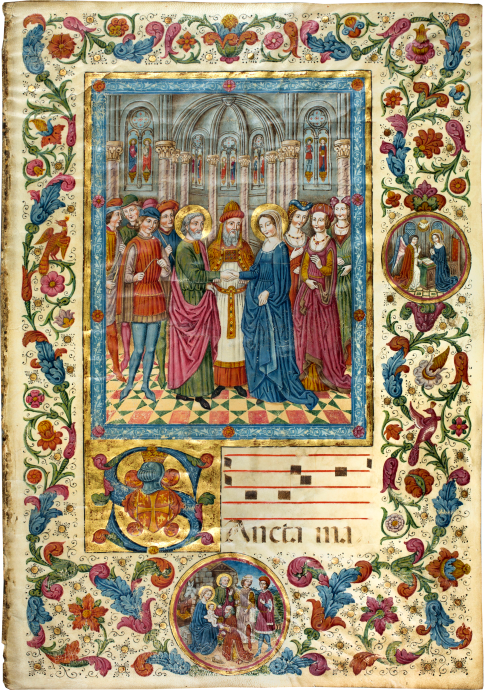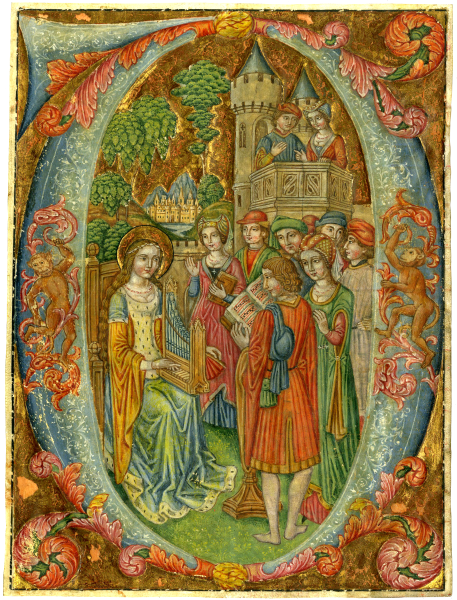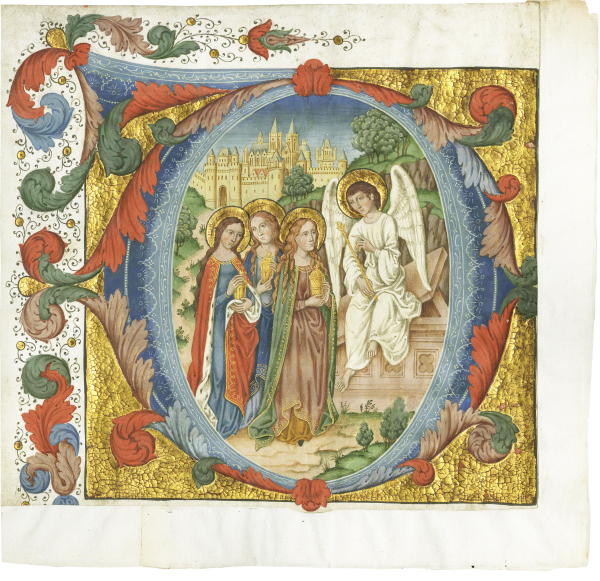


The Spanish Forger
, perhaps after 1925The Spanish Forger
Description
The Spanish Forger painted many full-page miniatures but the present example is uncommonly ornate, with a large central image, two historiated roundels, and richly decorated borders with birds. The Marriage of the Virgin is painted at center, with Mary and Joseph joining hands in the presence of the high priest and wedding party. Based on the Golden Legend, Joseph’s flowering rod revealed his divine ordination as Mary’s betrothed, while the other men snap their rods in disappointment. The composition is drawn from paintings by Raphael, Ghirlandaio, and Luini, as reproduced in illustrated volumes published in Paris by Firmin-Didot, from which the Forger is known to have worked – in this case most likely U. Maynard’s La Sainte Vierge (1877, pp. 135-138). The marriage scene is depicted inside a vaulted cathedral with historiated stained glass windows and marble columns; the priest’s gemstone ephod and the fantastic architectural setting recall elements from other works by the Forger, particularly the leaf with the Presentation of Christ in the Temple at Dartmouth College Library (L21; MS. 2088). A roundel in the right border depicts the Annunciation, and a larger roundel at bottom the Adoration of the Magi. The initial ‘S’ includes a heraldic device with gold cross and four fleur-de-lis on a red shield with crowned helmet.
W. Voelkle notes that the Spanish Forger must have responded to the taste of the period for initials cut from manuscripts when he painted single leaves. They are marginally larger than the rectangular narrative miniatures more typical of his oeuvre, but like them they utilize the same parchment stock – a dismembered fifteenth-century Italian Antiphonal. Although it is notoriously difficult to date the miniatures by this artist, Voelkle notes that none of the miniatures from this reused Antiphonal has a provenance that pre-dates 1925.
Unmasked in 1930 by Belle da Costa Green, then director of the Pierpont Morgan Library, the Spanish Forger is known today as one of the “most skillful and successful and prolific forgers of all times.” Hundreds of works are attributed to him and in 1978 a retrospective exhibition of his art was organized at the Pierpont Morgan Library in New York, revisited with an exhibition in 2014 at the Binghamton University Art Museum. He was active already in the 1890s and he was still painting in the 1920s. He borrowed freely from chromolithographic editions published in Paris for his compositions, especially the series of publications by Lacroix, which suggests that he may been employed by one of the Parisian publishing houses (remnants of old Parisian newspapers have been found inside the frames).
This miniature is painted on medieval parchment – a reused sheet from an Italian (or perhaps Spanish) Choir Book dated c. 1500 – with the antiphons “Sancta Maria Dei genitrix virgo” and “Dum esset rex” for the Office of the Virgin Mary. This leaf also demonstrates the Forger’s methods of working; scientific analyses of his paintings disclose the presence of green copper arsenite, which was not available before 1814. Apart from some minor cockling of the parchment and some rubbing of the paint in the borders and the blue initial ‘S,’ the miniature is in bright, fresh condition.
Literature
The present miniature is unpublished. On the work of the Spanish Forger see William Voelkle and Roger Wieck, The Spanish Forger, New York, 1978. On the Spanish Forger in general see Sandra Hindman, et al, Manuscript Illumination in the Modern Age: Recovery and Reconstruction, Evanston, 2001; William Voelkle, “The Spanish Forger: Master of Manuscript Chicanery,” in The Revival of Medieval Illumination: Nineteenth-Century Belgium Manuscripts and Illuminations from a European Perspective, ed. Thomas Coomans and Jan de Maeyer, Leuven, 2007.

